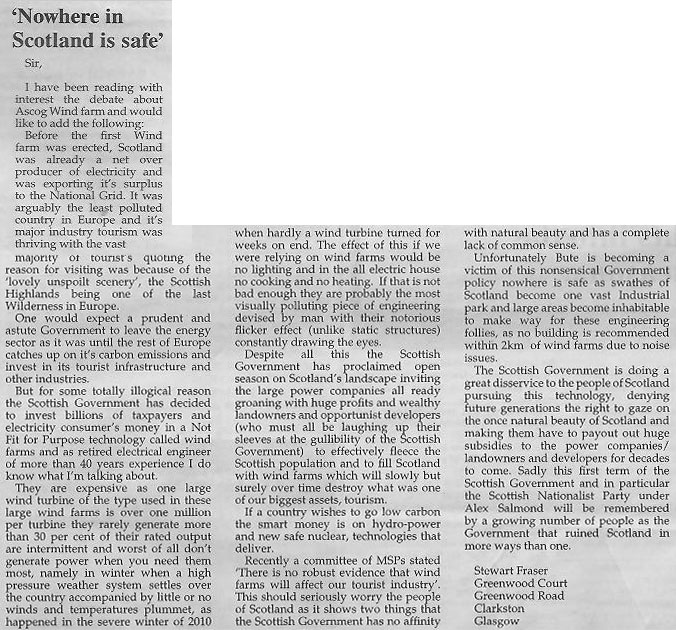It’s quite a busy week in The Buteman this week with five letters on the wind energy topic.
Taking them in the order in which they were printed, first off is Brandane (native of Bute) Mr Stephen Johnstone of Ardentinny.

©The Buteman
It’s interesting to note, as Mr Johnstone does, ‘If we’re not careful [Rothesay] will go under’. This letter must rank as one of the most lucid of the last year or more, acknowledging that wind farms will go up anyway, suggesting that the money they bring might actually be useful and attempting to focus on some of the issues – such as dereliction in Rothesay and high ferry fares – that are either symptomatic or causative of decline on Bute.
Next Mr Mick Common of Port Bannatyne. Mr Common wrote in last week’s paper but, unfortunately, his erudite remarks were beset with some Buteman typographical errors.

©The Buteman
Horror indeed if global temperatures were to rise by 20oC. Warming of +2oC seems relatively likely and if we don’t do anything much quite soon it looks like future generations could be looking at a +4oC warmer world – with quite a few attendant, and problematic, consequences.
Next Mr Tony Burns of Ardbeg who suggests the ‘Real question is: where to put turbines?’ The answer, it would appear, is far away where you cannot see them…
Of course, Mr Burns’ question as to where to put wind turbines generally, and specifically whether Ascog Farm could accommodate any (and of what size) is very pertinent. Placement at Ascog will be decided by Argyll & Bute Council and/or Scottish Ministers with reference to the Environmental Impact Assessment and input from statutory consultees.
Onshore wind, as the Institute for Public Policy Research has noted, is ‘currently the cheapest of the renewable technologies’ and much cheaper to install and maintain than distant offshore wind. The only trouble is, wherever anyone tries to put any up, anti-turbine groups soon form who don’t want to see them anywhere near where they live! Perhaps
policy makers will have the final say, since more turbines are likely to go up throughout the UK as governments attempt to ‘decarbonise’ energy systems.
Next Mr Reid of Millburn Cottage, Ascog. Mr Reid wrote a couple of weeks back confidently stating that global warming had ceased in 1996. Here he goes over old ground again…

©The Buteman
A lot could be written on the climate change ‘sceptic’ or ‘denial’ position of Mr Reid’s letter but we’ll leave that to scientists or other letter writers to The Buteman. All we know is that Ascog is a windy site, could economically produce power using a proven technology and that income from this scheme would diversify the farm and (both directly and indirectly) benefit the local economy probably creating employment and jobs in the process. Not all bad then…
Finally Mr Stewart Fraser of Clarkston, Glasgow. Apparently, ‘Nowhere in Scotland is safe’. Surely we’re not ‘all doomed’!

©The Buteman
A lot of the classic arguments about ‘inefficency’ and ‘intermittency’ are present here in Mr Fraser’s letter, together with ripe little gems about ‘landowners and opportunistic developers [fleecing] the Scottish population’, allusions to the threat to Scotland’s prime industry of tourism, effects of noise, non-existent ‘2km’ minimum separation distances and so forth. Much of this has been covered ad nauseum in various News articles on this site. Additional, and informative, reading on the issues raised may also be found in the Centre for Sustainable Energy’s publication Common concerns about wind power.
Mr Fraser states that ‘if a country wishes to go low carbon the smart money is on hydro-power and new safe nuclear, technologies that deliver.’ Unfortunately, hydro tends to be enormously expensive to develop whilst new (and even more expensive!) nuclear plants won’t be up and running for another twenty years or more.
Consequently, it is quite clear that energy from the wind will form an important part of the UK’s renewables mix for years to come.
Let’s hope that Ascog, in one of the windiest parts of Scotland (in turn one of the windiest parts of Britain which is one of the windiest parts of Europe) can play its part in delivering clean, green power over the coming years.
